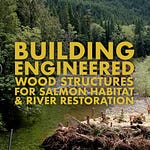Bog ecosystems are often overlooked because of their soggy soils, small trees and sometimes funky smells, but these ancient ecosystems are a super important carbon store, biodiversity hub and in general, are pretty dang neat!
Here, layers of sphagnum moss builds up over centuries which restricts water flow, causing it to become highly anaerobic and highly acidic as things decompose very slowly, and as a result, very few trees can grow here, and those that do often have shallow roots that either don’t dive too deep into acidic waters or are very tolerant and able to grow in poor soil conditions like Yellowcedar and Shorepines.
After enough time, hummocks form around the bases of these trees and things begin to grow and stack up upon the moss just above the water table, eventually tapering off into Muskeg Forest of Hemlocks, Redcedars and Spruces where more soil is present, creating a really unique, vibrant and diverse ecosystem that takes hundreds to thousands of years to evolve.
Despite being small, scraggly trees, these forest ecosystems can be hundreds to thousands of years old, which technically makes them Old Growth Forests, though…they probably look much different than what you imagine an Old Growth Forest to look like.
Low-productivity Old Growth Forests like this one here makes up over 80% of the remaining Old Growth forest left in the province while the remaining high-productivity Old Growth forests that contain those amazing massive trees seen all over in tourism ads were down to 2.7% of their historic numbers, or less than 1% of all forests in BC, about 4 years ago…yet they continue to be actively logged today, so that number is significantly lower, and the situation in the States unfortunately is even worse.
Since there is little demand to log these older, smaller less productive forests, they disproportionately make up a majority of protected forest areas while the few remaining higher productivity forests continue to be logged. Thats not to say that these forests aren’t worth protecting, but that their protection is often used as a greenwashed veil to the fact that the larger, more biologically diverse and ecologically complex forests are still falling, when what we need is proportionate protections for all forest types to ensure healthy biodiversity, ecological and climate functions are preserved in an uncertain future.
It almost seems as if the government has more interest in protecting the industry status quo and those in positions of power than it does protecting these forests, our future and doing what the people they were elected to serve actually want…but what do I know, I’m just a guy who likes trees!
If you’re enjoying these vids and want more of ‘em, you can help support their production by becoming a paid supporter on patreon or substack 🤙












Share this post